Efficiency of the Drawdown Flushing and Partition Desilting of a Reservoir in Taiwan
Abstract
1. Introduction
2. Materials and Methods
2.1. Study Area
2.2. Identifying the Sediment Release Efficiency Correlationships
2.2.1. Data Used and Analyses
2.2.2. Statistics
2.3. Modeling Drawdown Scenarios
2.3.1. Sedimentation and River Hydraulics (SRH-2D) Numerical Model
2.3.2. Initial and Boundary Conditions
2.3.3. Scenario Design
- (1)
- Baseline scenarios: The first type involved the current management conditions in practice, and so were considered baseline scenarios (i.e., drawdown strategies A1, B1, C1, and D1 in Table 1).
- (2)
- Partition desilting scenarios: The second type involved partition desilting, where the reservoir is divided under incrementally changing water surface conditions. Specifically, simulations included Agongdian Reservoir being divided into two compartments to separate the inflow of the Zhoushui River and the Wanglai River. Each partition desilting scenario moves further away from the baseline conditions, and the initial water levels of the reservoir incrementally decrease from approximately 31 m to 27 m (i.e., drawdown strategies A2 to A5; B2 to B4; C2 to C3, and D2 to D4 in Table 1).
- (3)
- Empty flushing scenarios: The third type of scenario involved modeling for the reservoir to be entirely flushed when the reservoir is already empty and without any partitioning (i.e., drawdown strategies A7, B6, C5, and D5 in Table 1).
- (4)
- Empty flushing with partitioning scenarios: The fourth type of simulated operations involved a combination of partitioned desilting when the reservoir is already empty (i.e., drawdown strategies A6, B5, C4, and D4 in Table 1).
2.3.4. Statistics
3. Results
3.1. Flushing Efficiency and Its Relationship with Selected Factors
3.2. Numerical Modeling Results
3.2.1. Calibration and Validation Results
3.2.2. Simulation Results
4. Discussion
4.1. Factors Associated with the Efficiency of Flushing
4.2. Reservoir Compartmentation
4.3. Reservoir Policy Implications
5. Conclusions
- (1)
- Long-term observed monitoring data was valuable in identifying factors highly related to flushing efficiency, which included the initial water level, average water level, and average velocity.
- (2)
- Compartmentalization of the reservoir is a proposed strategy that has demonstrated high levels of improvement in flushing efficiency in this study, depending on the particular scenario involving partition desilting, empty flushing, or a combination of both.
- (3)
- Recommendations to increase flushing efficiency include: lowering the initial water level, creating narrower gorge-like geometry by partitioning, and considering to modify the operation rules (i.e., duration of the flushing period, outflow discharge, etc.)
- (4)
- Experiences of practicing drawdown flushing should be documented more frequently to help inform existing and future practices.
- (5)
- Many types of barriers exist in practicing sustainable reservoir management, including social, technical, and economic issues. More scientifically-documented experiences, such as the findings in this study, ought to be accumulated.
Author Contributions
Funding
Conflicts of Interest
References
- Harada, M. Operational results and effects of sediment bypass system. In Proceedings of the 20th ICOLD Conference, Beijing, China, 19–22 September 2000. [Google Scholar]
- Kondolf, G.M.; Gao, Y.; Annandale, G.W.; Morris, G.L.; Jiang, E.; Zhang, J.; Cao, Y.; Carling, P.; Fu, K.; Guo, Q.; et al. Sustainable sediment management in reservoirs and regulated rivers: Experiences from five continents. Earth’s Future 2014, 2, 256–280. [Google Scholar] [CrossRef]
- Basson, G. Hydraulic measures to deal with reservoir sedimentation: Flood flushing, sluicing and density current venting. In Proceedings of the 3rd International Conference on River Flood Hydraulics, Stellenbosch, South Africa, 5–7 November 1997. [Google Scholar]
- Palmieri, A.; Shah, F.; Annandale, G.; Dinar, A. Reservoir Conservation—Economic and Engineering Evaluation of Alternative Strategies for Managing Sedimentation in Storage Reservoirs: The RESCON Approach; World Bank: Washington, DC, USA, 2003; Volume 1. [Google Scholar]
- White, R. Evacuation of Sediments from Reservoirs; Thomas Telford: London, UK, 2001. [Google Scholar]
- Morris, G.L.; Fan, J.X. Reservoir Sedimentation Handbook: Design and Management of Dams, Reservoirs, and Watersheds for Sustainable Use; McGraw Hill Professional: New York, NY, USA, 1998. [Google Scholar]
- Kawashima, S.; Johndrow, T.B.; Annandale, G.W.; Shah, F. Reservoir Conservation—Economic and Engineering Evaluation of Alternative Strategies for Managing Sedimentation in Storage Reservoirs: RESCON Model and User Manual; World Bank: Washington, DC, USA, 2003; Volume 2. [Google Scholar]
- Sumi, T. Evalutation of Efficienca of Reservoir Sediment Flushing in Kurobe River. In Proceedings of the 4th International Conference on Scour and Erosion (ICSE-4), Tokyo, Japan, 5–7 November 2008. [Google Scholar]
- Atkinson, E. The Feasibility of Flushing Sediment from Reservoirs; Hydraulics Research: Wallingford, UK, 1996. [Google Scholar]
- Scheuerlein, H. Sediment Sluicing in Mountain Reservoirs. In Fluvial Hydraulics of Mountain Regions; Springer Berlin Heidelberg: Heidelberg, Germany, 1991; pp. 223–234. [Google Scholar]
- Brown, C.B. The Control of Reservoir Silting; United States Department of Agriculture, Miscellaneous Publication No. 521: Washington, DC, USA, 1944; p. 166.
- Kantoush, S.; Sumi, T.; Suzuki, T.; Murasaki, M. Impacts of sediment flushing on channel evolution and morphological processes: Case study of the Kurobe River, Japan. In Proceedings of the 5th River Flow Conference, Braunschweig, Germany, 8–10 June 2010. [Google Scholar]
- IRTCES. Lecture Notes of the Training Course on Reservoir Sedimentation; Tsinghua University: Beijing, China, 1985. [Google Scholar]
- Lai, J.-S.; Shen, H.W. Flushing sediment through reservoirs. J. Hydraul. Res. 1996, 34, 237–255. [Google Scholar] [CrossRef]
- Muhammad, A.; Habib, U. Worldwide Experience of Sediment Flushing Through Reservoirs. J. Eng. Technol. Mehran Univ. Res. 2012, 31, 395–408. [Google Scholar]
- Wang, H.-W.; Kondolf, M.; Tullos, D.; Kuo, W.C. Sediment management in Taiwan’s reservoirs and barriers to implementation. Water 2018, 10, 1034. [Google Scholar] [CrossRef]
- WRA. Effect Assessment of Empty Storage Operation for Sediment Prevention and Sand Observation Program of Agoden Reservoir in 2009; Southern Region Water Resources Office: Tainan, Taiwan, 2009.
- WRA. Effect Assessment of Empty Storage Operation for Sediment Prevention Observation Program of Agoden Reservoir in 2010; Southern Region Water Resources Office: Tainan, Taiwan, 2010.
- WRA. Effect Assessment of Empty Storage Operation for Sediment Prevention Observation Program of Agoden Reservoir in 2011; Southern Region Water Resources Office: Tainan, Taiwan, 2011.
- WRA. Sediment Observation and Efficiency Evaluation for desiltation of Agongdian Reservoir by using empty flushing in 2012; Southern Region Water Resources Office: Tainan, Taiwan, 2012.
- WRA. Sediment Observation and Efficiency Evaluation for Desiltation of Agongdian Reservoir by Using Empty Flushing in 2013; Southern Region Water Resources Office: Tainan, Taiwan, 2013.
- WRA. Sediment Observation and Efficiency Evaluation for Desiltation of Agongdian Reservoir by Using Empty Flushing in 2014; Southern Region Water Resources Office: Tainan, Taiwan, 2014.
- WRA. Sediment Observation and Efficiency Evaluation for Desiltation of Agongdian Reservoir by Using Empty Flushing in 2015; Southern Region Water Resources Office: Tainan, Taiwan, 2015.
- WRA. Hydraulic Model Studies on the Functions and Operations of Silting Prevention in A-Kung-Tien Reservoir—Final Report; Water Resources Planning Institute: Taichung, Taiwan, 2003.
- Lee, D.-H.; Chen, P.Y.; Wu, J.H.; Chen, H.L.; Yang, Y.E. Method of mitigating the surface erosion of a high-gradient mudstone slope in southwest Taiwan. Bull. Eng. Geol. Environ. 2013, 72, 533–545. [Google Scholar] [CrossRef]
- Chen, C.-N.; Tsai, C.-H. Estimating Sediment Flushing Efficiency of a Shaft Spillway Pipe and Bed Evolution in a Reservoir. Water 2017, 9, 924. [Google Scholar] [CrossRef]
- WRA. Directions on Agondian Reservoir Operation; Southern Region Water Resources Office: Tainan, Taiwan, 2011.
- CWB. Central Weather Bureau. Available online: https://www.cwb.gov.tw/V7/index.htm (accessed on 15 October 2016).
- Lai, Y. SRH-2D Version 2: Theory and User’s Manual, Sedimentation and River Hydraulics–Two-dimensional River Flow Modeling; US Department of the Interior, Bureau of Reclamation, Technical Service Center: Denver, CO, USA, 2008.
- Lai, Y.G. Numerical Model Development for River and Reservoir Applications—2014 Progress; Reclamation: Denver, CO, USA, 2014. [Google Scholar]
- Lai, J.-S.; Lee, F.Z.; Wu, C.H.; Tan, Y.C.; Sumi, T. Sediment Bypass Tunnels of the Shihmen Reservoir in Taiwan. In First International Workshop on Sediment Bypass Tunnels; VAW-Mitteilung 232 (Boes R M, ed.); Laboratory of Hydraulics, Hydrology and Glaciology (VAW): ETH Zurich, Switzerland, 2015. [Google Scholar]
- Lai, Y.G. Channel Morphology Prediction with and without a Temporary Channel Upstream of the Elephant Butte Reservoir. In Proceedings of the World Environmental and Water Resources Congress: Crossing Boundaries, Albuquerque, New Mexico, 20–24 May 2012. [Google Scholar]
- Te Chow, V. Open Channel Hydraulics; McGraw-Hill Book Company, Inc.: New York, NY, USA, 1959. [Google Scholar]
- Lewis, C.D. Industrial and Business Forecasting Methods: A Practical Guide to Exponential Smoothing and Curve Fitting; Butterworth-Heinemann: London, UK, 1982. [Google Scholar]
- Engelund, F.; Hansen, E. A Monograph on Sediment Transport in Alluvial Streams; Technical University of Denmark: Copenhagen, Denmark, 1967. [Google Scholar]
- WRA. The Rehabilitation Plan of Ta-Pu Reservoir; Northern Region Water Resources Office: Taoyuan, Taiwan, 2009.
- Chang, F.J.; Lai, J.S.; Kao, L.S. Optimization of operation rule curves and flushing schedule in a reservoir. Hydrol. Process. 2003, 17, 1623–1640. [Google Scholar] [CrossRef]
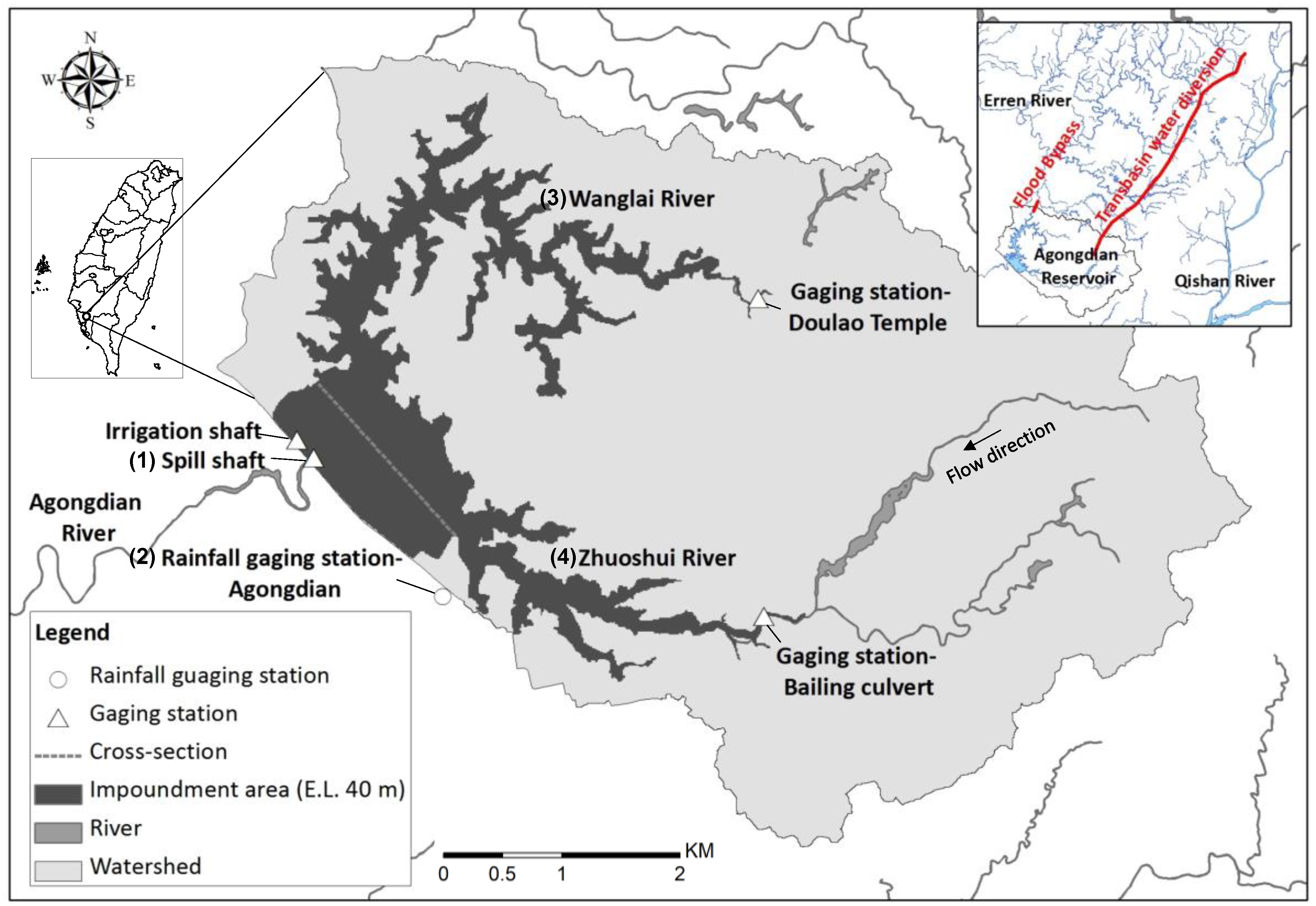

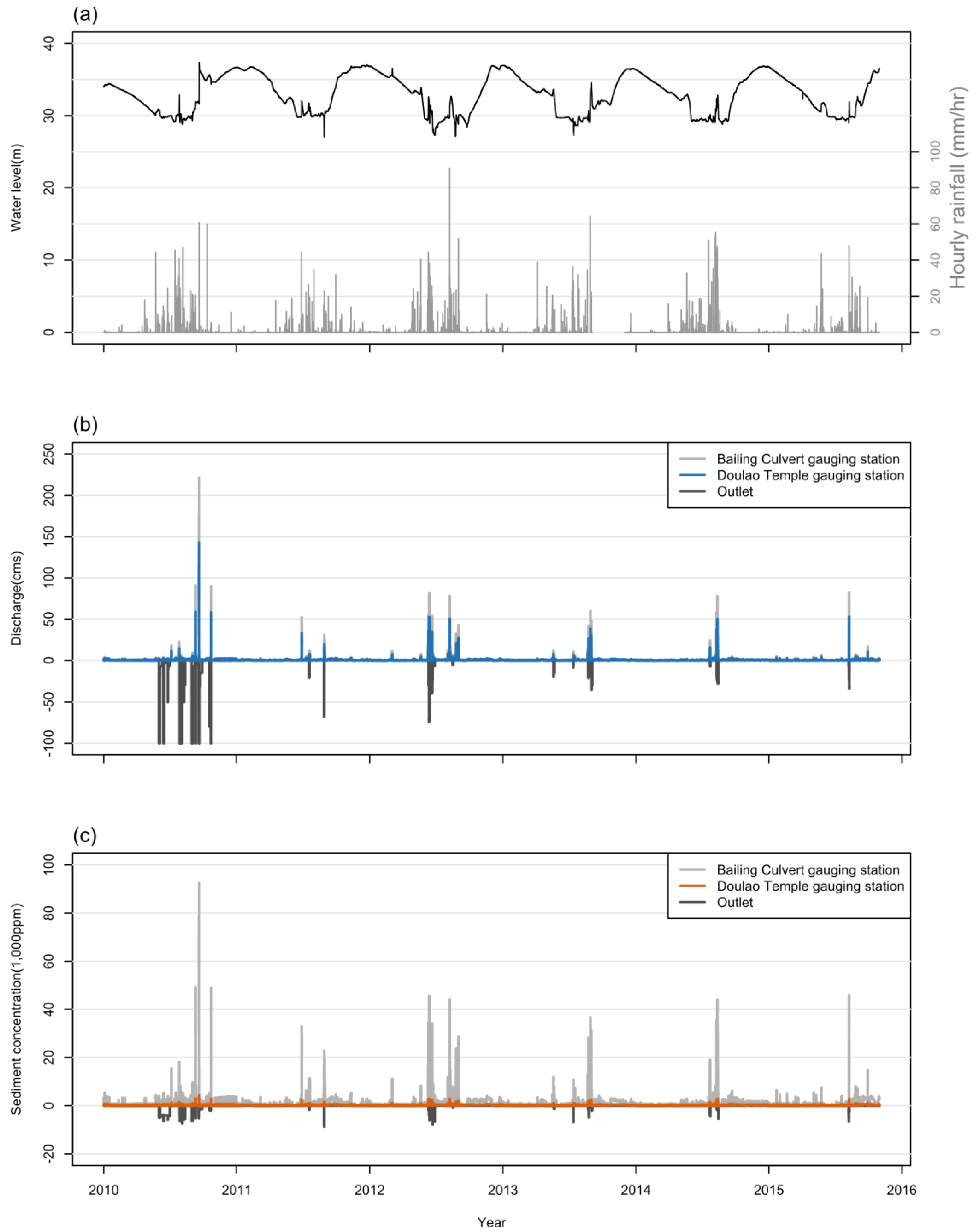

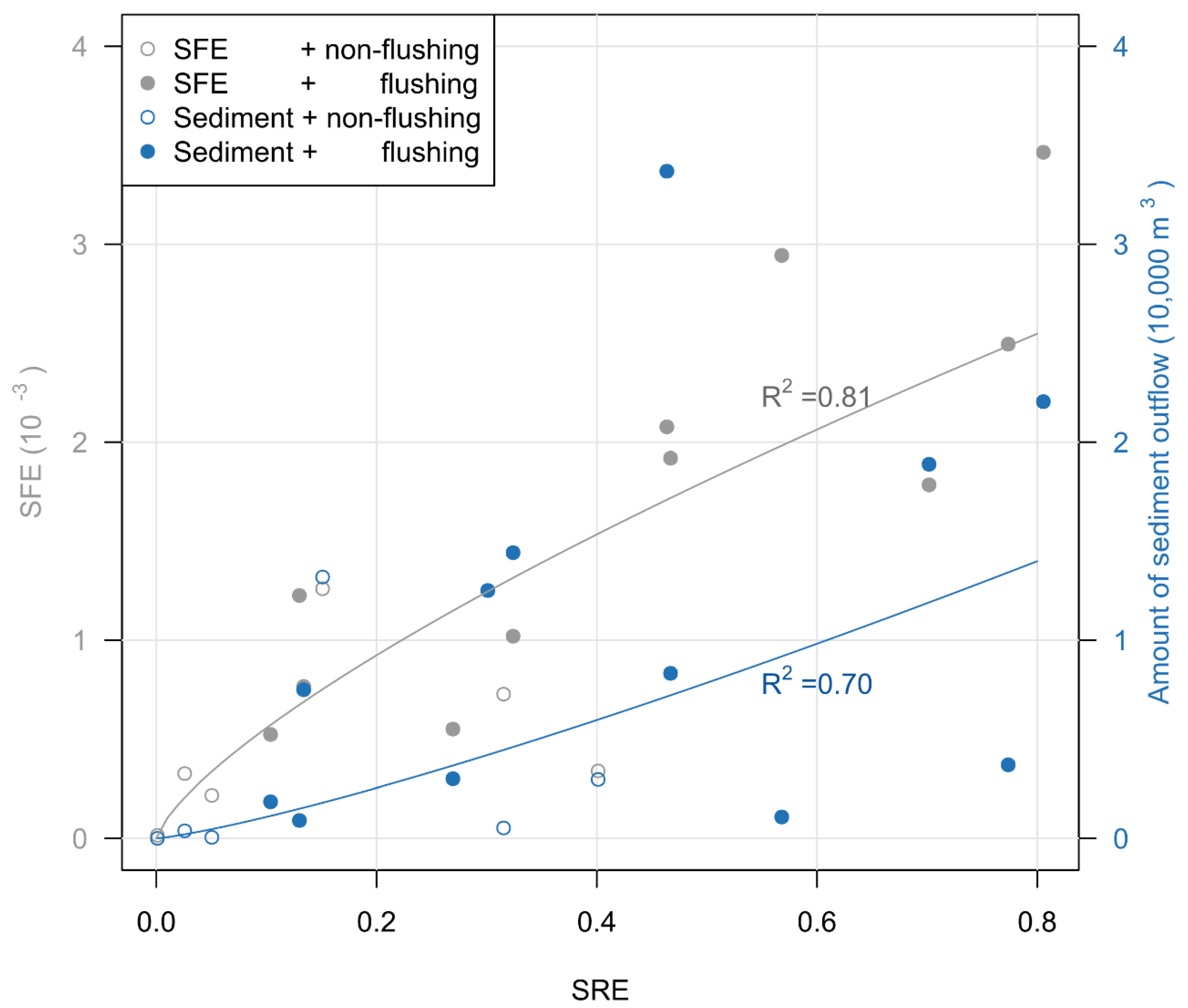
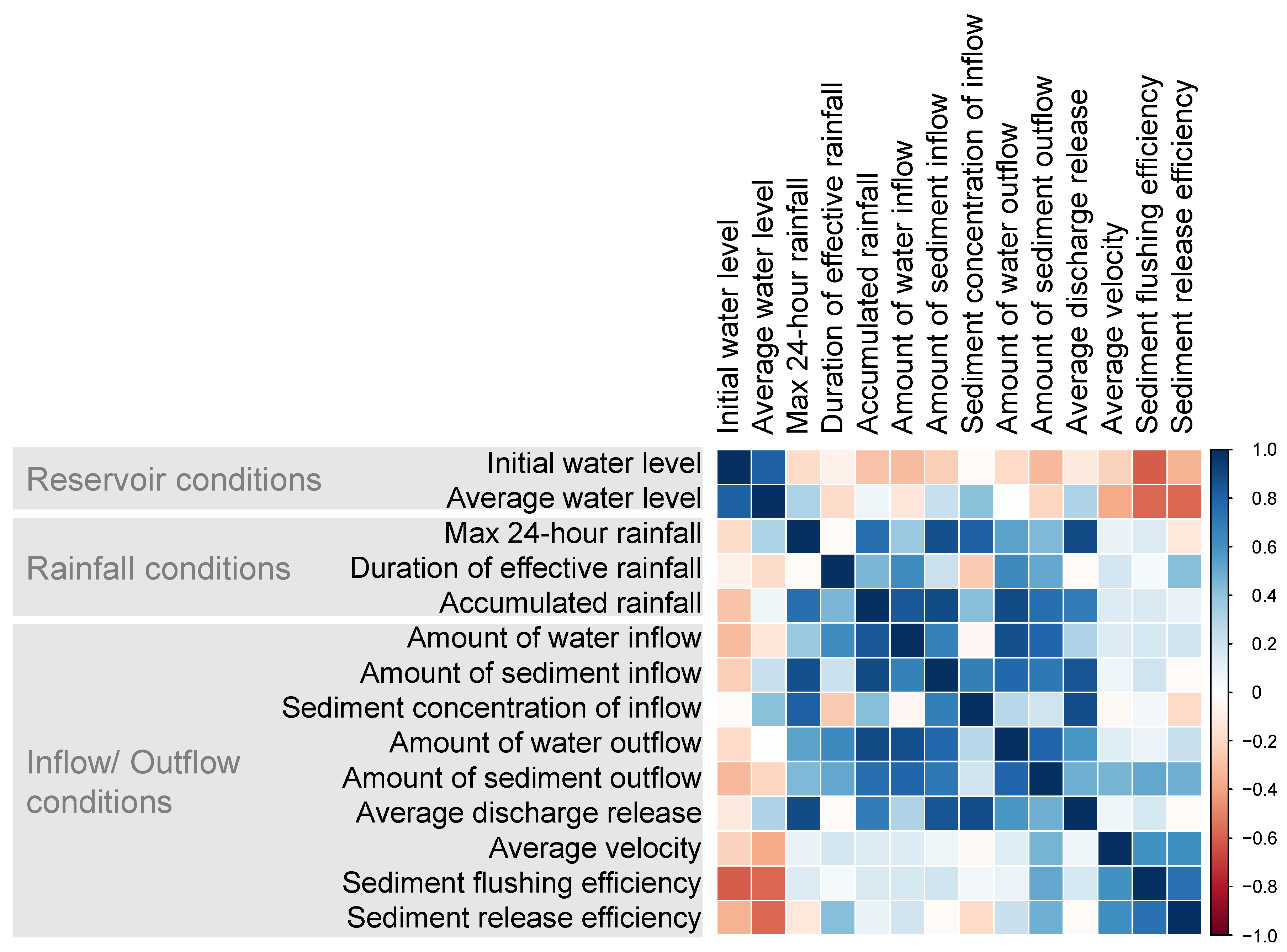



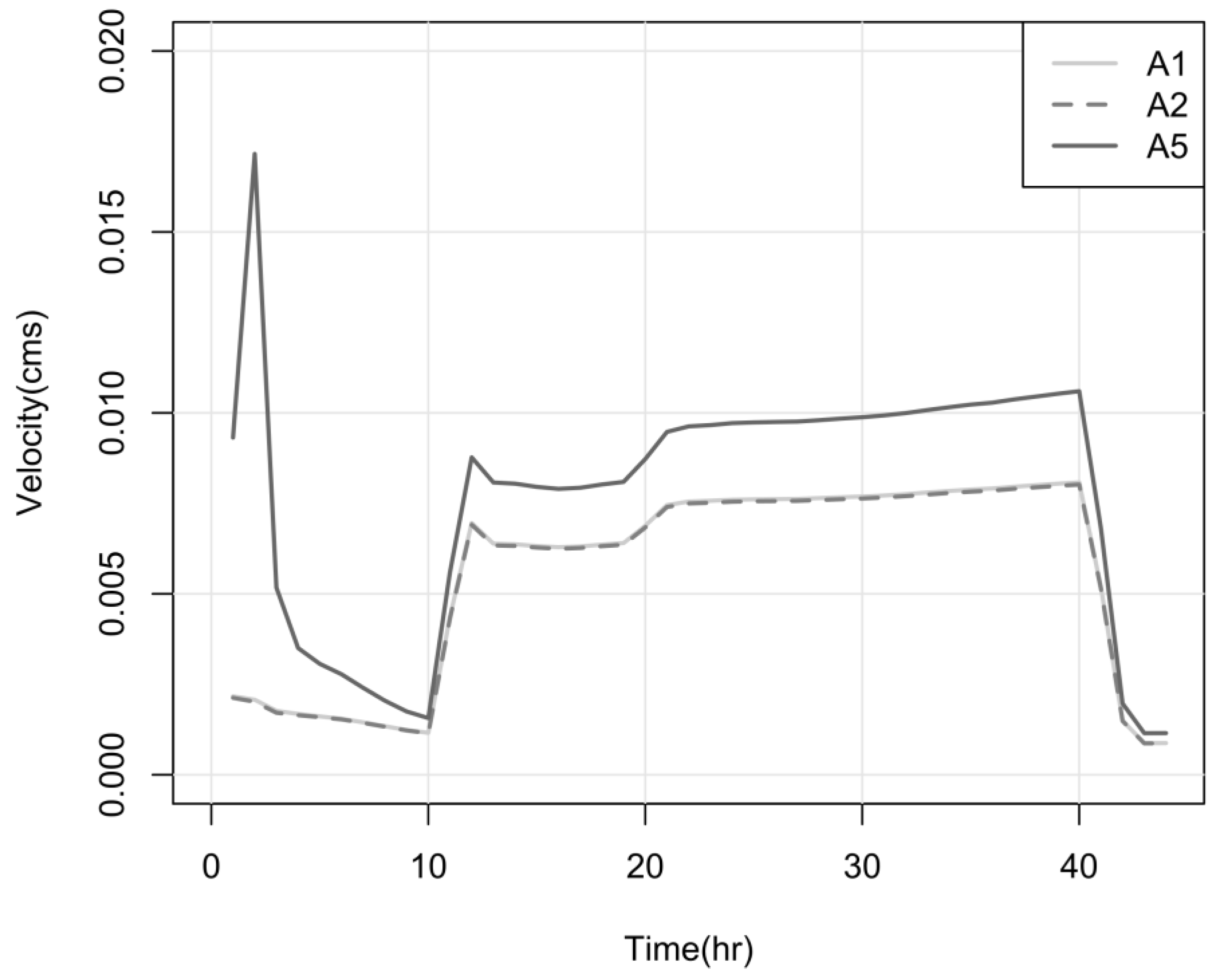
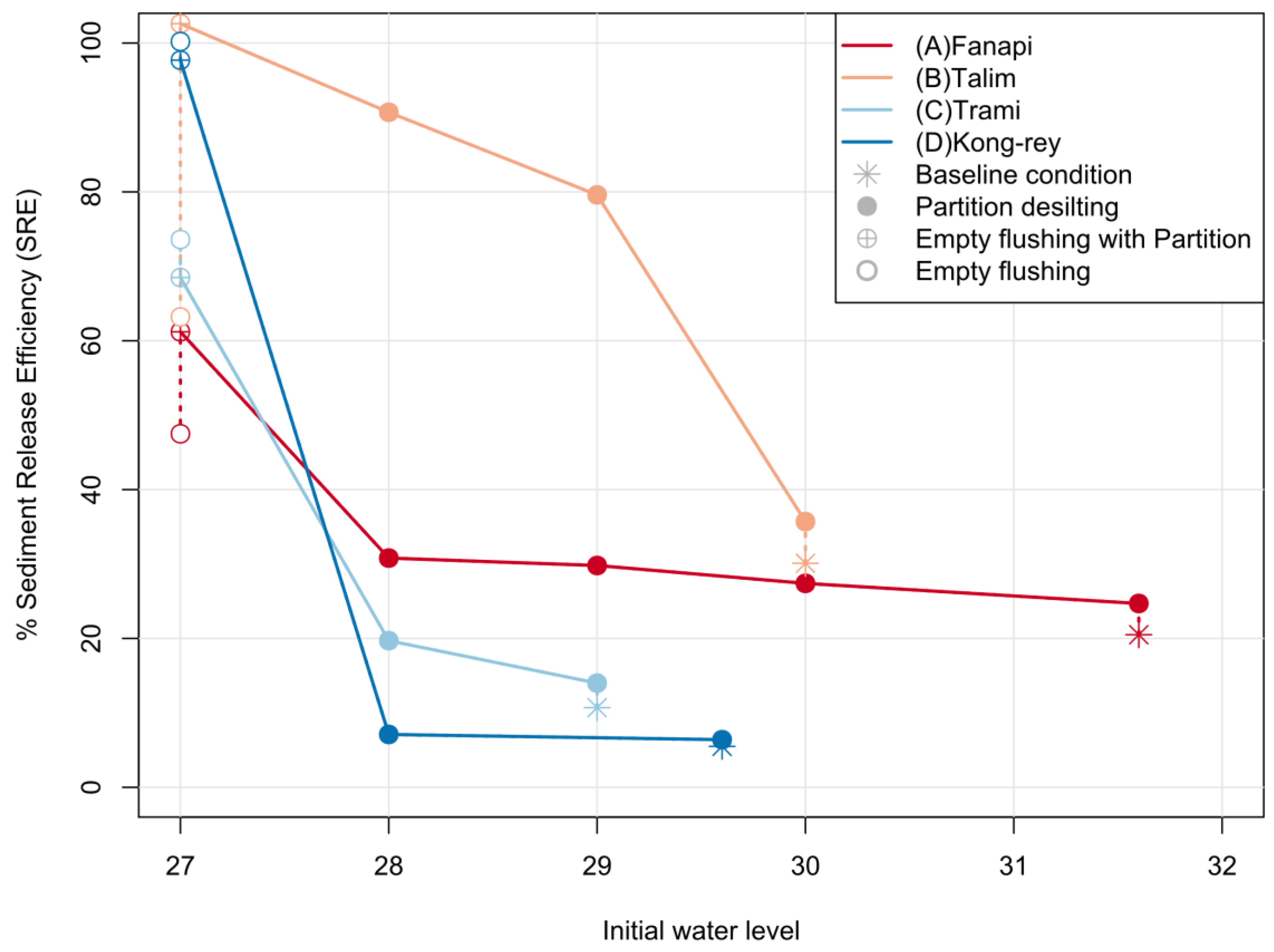
| Scenario (Target Level of Drawdown Water Surface) | Typhoon Event | |||
|---|---|---|---|---|
| Fanapi | Talim | Trami | Kongrey | |
| Baseline condition | A1 (31.6 m) | B1 (30.0 m) | C1 (29.0 m) | D1 (29.6 m) |
| Partition desilting (31 m) | A2 (31.6 m) | |||
| Partition desilting (30 m) | A3 (30.0 m) | B2 (30.0 m) | ||
| Partition desilting (29 m) | A4 (29.0 m) | B3 (29.0 m) | C2 (29.0 m) | D2 (29.6 m) |
| Partition desilting (28 m) | A5 (28.0 m) | B4 (28.0 m) | C3 (28.0 m) | D3 (28.0 m) |
| Empty flushing with Partition (27 m) | A6 (27.0 m) | B5 (27.0 m) | C4 (27.0 m) | D4 (27.0 m) |
| Empty flushing only (27 m) | A7 (27.0 m) | B6 (27.0 m) | C5 (27.0 m) | D5 (27.0 m) |
| Typhoon Event | ||||
|---|---|---|---|---|
| Fanapi | Talim | Trami | Kong-Rey | |
| Period | 19 September 2010 11:00–21 September 2010 07:00 | 18 June 2012 21:00–24 June 2012 01:00 | 21 August 2013 18:00–25 August 2013 19:00 | 28 August 2013 11:00–09 March 2013 07:00 |
| Initial water level (m) | 31.6 | 30.3 | 29.4 | 29.6 |
| Average water level (m) | 36.1 | 29.2 | 29.9 | 32.9 |
| Max 24-h rainfall (mm) | 569 | 188 | 135 | 327 |
| Duration of effective rainfall (h) | 27 | 123 | 96 | 97 |
| Accumulated rainfall (mm) | 589 | 380 | 198 | 556 |
| Water inflow (M m3) | 3.10 | 8.49 | 4.57 | 12.86 |
| Sediment inflow (M m3) | 873.38 | 269.11 | 178.22 | 560.27 |
| Water outflow (M m3) | 10.47 | 10.58 | 4.34 | 9.79 |
| Sediment outflow (M m3) | 131.88 | 188.83 | 83.22 | 74.96 |
| Average discharge release (m3/s) | 64.63 | 23.52 | 12.29 | 19.28 |
| Average velocity (m/s) | 0.0054 | 0.194 | 0.0048 | 0.0027 |
| Sediment concentration of inflow | 0.0281 | 0.0032 | 0.0039 | 0.0044 |
| Sediment flushing efficiency (%) | 0.13 | 0.18 | 0.19 | 0.08 |
| Sediment release efficiency (%) | 15 | 70 | 47 | 13 |
| Drawdown Strategy | Sediment Inflow (103 m3) | Initial Water Surface Level (m) | Sediment Outflow (103 m3) | Sediment Release Efficiency (%) | Percentage of Improvement (%) |
|---|---|---|---|---|---|
| A1 | 87.3 | 31.6 | 17.9 | 20.5 | - |
| A2 | 31.6 | 21.6 | 24.7 | 21 | |
| A3 | 30 | 23.9 | 27.4 | 34 | |
| A4 | 29 | 26 | 29.8 | 45 | |
| A5 | 28 | 26.9 | 30.8 | 50 | |
| A6 | 27 | 53.4 | 61.2 | 198 | |
| A7 | 27 | 41.5 | 47.5 | 132 | |
| B1 | 26.9 | 30 | 8.1 | 30.1 | - |
| B2 | 30 | 9.6 | 35.7 | 19 | |
| B3 | 29 | 21.4 | 79.6 | 164 | |
| B4 | 28 | 24.4 | 90.7 | 201 | |
| B5 | 27 | 27.6 | 102.6 | 241 | |
| B6 | 27 | 17 | 63.2 | 110 | |
| C1 | 17.8 | 29 | 1.9 | 10.7 | - |
| C2 | 29 | 2.5 | 14.0 | 32 | |
| C3 | 28 | 3.5 | 19.7 | 84 | |
| C4 | 27 | 12.2 | 68.5 | 542 | |
| C5 | 27 | 13.1 | 73.6 | 589 | |
| D1 | 56.1 | 29.6 | 3.1 | 5.5 | - |
| D2 | 29.6 | 3.6 | 6.4 | 16 | |
| D3 | 28 | 4 | 7.1 | 29 | |
| D4 | 27 | 54.8 | 97.7 | 1668 | |
| D5 | 27 | 56.2 | 100.2 | 1713 |
© 2020 by the authors. Licensee MDPI, Basel, Switzerland. This article is an open access article distributed under the terms and conditions of the Creative Commons Attribution (CC BY) license (http://creativecommons.org/licenses/by/4.0/).
Share and Cite
Wang, H.-W.; Tsai, B.-S.; Hwang, C.; Chen, G.-W.; Kuo, W.-C. Efficiency of the Drawdown Flushing and Partition Desilting of a Reservoir in Taiwan. Water 2020, 12, 2166. https://doi.org/10.3390/w12082166
Wang H-W, Tsai B-S, Hwang C, Chen G-W, Kuo W-C. Efficiency of the Drawdown Flushing and Partition Desilting of a Reservoir in Taiwan. Water. 2020; 12(8):2166. https://doi.org/10.3390/w12082166
Chicago/Turabian StyleWang, Hsiao-Wen, Bing-Shiou Tsai, Charnsmorn Hwang, Guan-Wei Chen, and Wei-Cheng Kuo. 2020. "Efficiency of the Drawdown Flushing and Partition Desilting of a Reservoir in Taiwan" Water 12, no. 8: 2166. https://doi.org/10.3390/w12082166
APA StyleWang, H.-W., Tsai, B.-S., Hwang, C., Chen, G.-W., & Kuo, W.-C. (2020). Efficiency of the Drawdown Flushing and Partition Desilting of a Reservoir in Taiwan. Water, 12(8), 2166. https://doi.org/10.3390/w12082166





